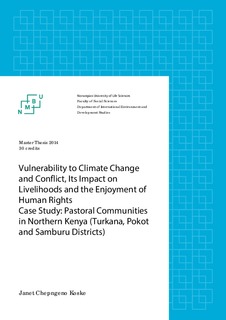| dc.contributor.author | Koske, Janet Chepngeno | |
| dc.date.accessioned | 2014-11-03T12:59:28Z | |
| dc.date.available | 2014-11-03T12:59:28Z | |
| dc.date.copyright | 2014 | |
| dc.date.issued | 2014-11-03 | |
| dc.identifier.uri | http://hdl.handle.net/11250/225296 | |
| dc.description.abstract | The relationship between climate change and conflict is a complex one. Violent conflicts
involving pastoralists have become widespread and increasingly severe in the North Rift and
North Eastern regions of Kenya. This study examines the factors contributing to such
conflicts, and discusses issues and priorities for conflict prevention and peace building. The
pastoralists in the three districts under study are largely nomadic. They live primarily in arid
or semi-arid areas and depend on livestock (cattle, sheep, goats and camels) for their
livelihood. They rely on access to pasture and water, for the survival of their livestock. Such
resources are scarce and under increasing pressure. Conflicts involving pastoralists associated
with resource competition, cattle rustling and wide availability of small arms are widespread
and of increasing concern. This Study thus provides a useful case to examine in depth factors
contributing to conflict, issues and priorities for conflict prevention. This study also looks at
how the livelihoods of pastoralists in Samburu, Pokot and Turkana is vulnerable to climate
change and conflict and ways in which these systems adapt to these conditions. The last part
of this work looks briefly at how climate change and conflicts affect human security.
Conflicts interfere with human rights like the right to life, the rights to adequate housing, the
right to health and the right to food. It discusses briefly how these rights are directly affected
when a society is hit by climatic changes like droughts or floods. The study uses interviews,
semi-structured and focus group interviews to gather data from local communities,
government officials and experts. It also uses secondary data from published and unpublished
sources and systematically analyzes this material using qualitative analysis. The result shows
that climate change is evident in the three districts in Northern Kenya. There’s evidence of
decreasing precipitation and increasing temperatures. Drought and unpredictable rainfall have
impacted greatly on the people’s livelihoods and this has resulted to migration,
overpopulation and resource conflicts. The vulnerability of pastoralism to climate change and
conflict is further worsened by the fact that this way of life is greatly marginalized. They
receive no support from the government and this just worsens the situation. Some of the
coping strategies that have been applied are mobility, trading, crop farming is slowly being
introduced, and drought resistant livestock like camels and goats are slowly being kept. This
paper suggests ways to reduce vulnerability thus ensuring that people’s rights are not violated. | nb_NO |
| dc.language.iso | eng | nb_NO |
| dc.publisher | Norwegian University of Life Sciences, Ås | |
| dc.rights | CC0 1.0 Universal | * |
| dc.rights.uri | http://creativecommons.org/publicdomain/zero/1.0/ | * |
| dc.title | Vulnerability to climate change and conflict, its impact on livelihoods and the enjoyment of human rights : case study: pastoral communities in Northern Kenya (Turkana, Pokot and Samburu Districts) | nb_NO |
| dc.type | Master thesis | nb_NO |
| dc.subject.nsi | VDP::Social science: 200::Political science and organizational theory: 240::International politics: 243 | nb_NO |
| dc.subject.nsi | VDP::Agriculture and fishery disciplines: 900::Agriculture disciplines: 910::Management of natural resources: 914 | nb_NO |
| dc.source.pagenumber | 96 | nb_NO |
| dc.description.localcode | M-IES | nb_NO |

